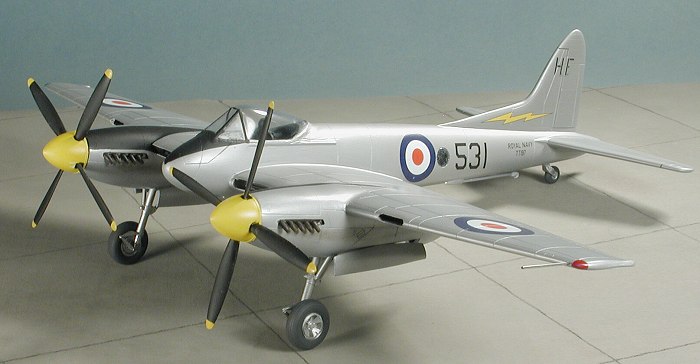
Classic Airframes 1/48 Hornet F.20
|
KIT # |
459 |
|
PRICE: |
$54.95 MSRP |
|
DECALS: |
two options |
|
REVIEWER: |
Scott Van Aken |
|
NOTES: |
Short run with resin and vac parts |

|
HISTORY |
The tremendous
wartime success of the De Havilland Mosquito led to the development of a
faster aircraft with the same basic features and construction techniques.
The resulting design was elegant, streamlined and with a top speed of 488
mph  (780 km/h), the Hornet was faster than jet fighters of the day. The
De Havilland Hornet in fact became the last piston-engined fighter to
serve in the Royal Air Force. Unfortunately, it while arrived too late to
see active service in World War II but the type remained in service well
into the 1950s.
(780 km/h), the Hornet was faster than jet fighters of the day. The
De Havilland Hornet in fact became the last piston-engined fighter to
serve in the Royal Air Force. Unfortunately, it while arrived too late to
see active service in World War II but the type remained in service well
into the 1950s.
The Royal Navy was also quick to see the usefulness of the design and suitable modifications including folding wings, an arrestor hook and other specialized equipment for seaborne use resulted in the F.20 Sea Hornet, the subject of this kit review. A later night fighter version, the NF.21 was also produced, both being especially useful as the turbojet still didn't have the range that was really needed for anything other than short range missions. The speed of the Hornet wasn't that much less than early jet fighters so for the RN, there was no problem operating these piston-engined beauties.
|
THE KIT |
Though this is not exactly a new kit and has been done already for Modeling Madness by Tom Cleaver, Tom didn't do this variant. The kit itself is very well molded in a softish medium grey plastic with nicely engraved panel lines that are not too shallow or too deep. My kit had no flash nor sink marks and what few ejector pin marks are present are easy to remove should the need arise.
There are two bags full of resin as this boxing will make either the
F.20 or F.21 version. Much of the resin is for the night fighter version,
the F.21 with its new nose, exhaust shields and rear radar operator's
position. As I had already decided on
 the F.20, these bits were consigned
to the spares box. The rest of the resin is for the cockpit, bomb racks,
tail wheel strut, and a few main landing gear pieces as well as the trim
tab actuator fairings (frankly, it would have been nice to have these
already molded in place).
the F.20, these bits were consigned
to the spares box. The rest of the resin is for the cockpit, bomb racks,
tail wheel strut, and a few main landing gear pieces as well as the trim
tab actuator fairings (frankly, it would have been nice to have these
already molded in place).
The kit also includes outer rocket rails, a tailhook and two sets of vacuformed bits, a very nice touch. Missing are any wing fold mechanism fairings which are actually rather prominent on the upper wings. Thanks to the rather high stance of the Hornet, these are rarely seen in photographs so it is understandable that they were missed. Also missing are any weapons for the rocket rails or the long range fuel tanks. You have also probably heard of the incorrect angle of the windscreen (i.e. it is too upright), but that can be cured if you are willing to put in a bit of effort. As it is my tendency to build supplied review kits basically out of the box, I'll probably not fix it.
Markings are provided for two aircraft, an extra dark sea grey over sky NF.21 and an overall painted aluminum F.20. Most Sea Hornets were pretty well devoid of any sort of color. Basically only tail codes and aircraft number differentiated from each plane. However, 728 Squadron at Hal Far in Malta did have yellow spinners and a lightning bolt on the fin of its F.20s and that scheme is included in the kit. The F.20 was also done in the extra dark sea grey over sky scheme and doing a semi-unique plane is quite easy simply with some aftermarket letter/number sets. For a look at the bits in the kit, please visit the preview
|
CONSTRUCTION |
I started this one by first gluing together a few
sub-assemblies. In this case it was the tail and tail planes. Then I
attacked the resin bits. These were, for the most part, easily removed from
the resin pouring stubs with a sharp scalpel, though the seat did require
some sawing. I simply rounded the stub edges of the cockpit tub and tail
wheel well as test fitting showed them to fit well with them still intact.
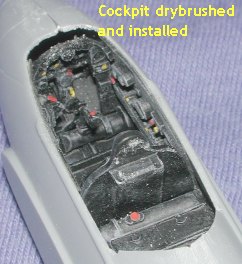
Then I assembled the cockpit bits. The seat won't fit all the way back unless you remove what seems to be an oxygen bottle that is on the armor plate. I also found that the control stick doesn't really want to fit that well unless the plate it is on is also removed. I left that plate on in fear of breaking the stick while removing it. The instrument panel also fits a bit farther back that I think it should go, but I'll deal with that later. The interior and side panels were then given a coat of matte black. The instructions recommend a black-grey, but dry brushing with a medium grey lightened things out quite a bit. I then picked out several bits with some red and yellow to add a dash of color. I would have liked for the seat to have belts molded on, but for those who want to add them it should be pretty easy. I left things stock.
Turning to the wings, I removed some ejector stubs that were in the way and then glued the resin radiator fronts on top of the small sill that is in the lower wing. I should mention at this time that one needs to be thorough in cleaning up the parts prior to gluing. Many of the sprue attachment points are intrusive into the part itself so there are small stubs that need sanded and smoothed out prior to any construction. Be careful not to miss any as it will just make construction a mess. Once the resin radiator grilles were glued on, I glued the wing halves together, but not the part atop the resin grilles. This was just in case I needed the extra slop room when the wings were butt glued against the fuselage.
While all that was drying, I assembled the props. These are
handed and turn in opposite directions. Build one at a time and mark the
back of the plate which one goes on what side. Most of us will simply glue
these on rather than have them spin to
 make construction and painting
easier. I also started to remove the resin exhaust from their stubs. After
breaking one in half during the sawing process, I realized that they would
fit in the nacelles without having to cut them from the pouring stubs, as
large as the stubs were. These were then rough trimmed with some cutters
and glued in place.
make construction and painting
easier. I also started to remove the resin exhaust from their stubs. After
breaking one in half during the sawing process, I realized that they would
fit in the nacelles without having to cut them from the pouring stubs, as
large as the stubs were. These were then rough trimmed with some cutters
and glued in place.
I then glued the tail wheel together and opened up the holes in the side of the fuselage for the clear windows. These are for cameras as it was quite common for naval fighters to have a secondary photo reconnaissance role. Most of the time the cameras were not carried. I opened them up by drilling five holes and then cutting that area out. Then I rough smoothed the area and finally rolled up a piece of 320 grit paper and carefully smoothed out the holes. During this process I frequently test fit one of the already trimmed vac windows to make sure I didn't go too far! Once all was properly fit into place, I glued them in with thin superglue and hoped I wouldn't punch one of them into the fuselage during the rest of the build!
The nacelles were then glued together. I glued the prop shaft in place as I knew I'd not be able to have the props spin anyway. There is a small bulkhead that goes in the forward section of the gear well. Make sure you remove the ejector stub and make sure that you glue the proper nacelle halves to each other as they are handed. The general fit of these is quite good and I only used sandpaper to take care of the seams.
 Back at
the fuselage, I installed the various cockpit sidewalls and test fit the
cockpit a number of times to be sure it fit. I initially tacked on the side
panels and then, before the glue dried, I dry-fit the interior to make sure
they dried in place. I did this on both sides. The tail wheel well was
glued in place at this time as well. When I was sure all fit, I permanently
attached the sidewalls by using water thin superglue and pressing the two
panels up against the fuselage until they dried. When I fit the fuselage
halves together, I noted that it was a very tight fit. You may want to
carve a bit from either the side panels or the fuselage sides to get a bit
of a looser fit, but it really isn't absolutely necessary. Starting at the
cockpit area, I put superglue on the joins and held them together until the
super glue dried. Then, using regular liquid cement, I glued the rest of
the fuselage halves together.
Back at
the fuselage, I installed the various cockpit sidewalls and test fit the
cockpit a number of times to be sure it fit. I initially tacked on the side
panels and then, before the glue dried, I dry-fit the interior to make sure
they dried in place. I did this on both sides. The tail wheel well was
glued in place at this time as well. When I was sure all fit, I permanently
attached the sidewalls by using water thin superglue and pressing the two
panels up against the fuselage until they dried. When I fit the fuselage
halves together, I noted that it was a very tight fit. You may want to
carve a bit from either the side panels or the fuselage sides to get a bit
of a looser fit, but it really isn't absolutely necessary. Starting at the
cockpit area, I put superglue on the joins and held them together until the
super glue dried. Then, using regular liquid cement, I glued the rest of
the fuselage halves together.
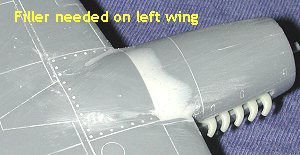 Meanwhile
at the wings, I started to glue the nacelles in place. The fit on the left
wing was less than good. I dry fit and trimmed and trimmed and dry fit, but
was unable to find exactly where the problem lie. I ended up using a lot of
glue and getting things as good as I could. Then I use epoxy putty to take
care of the areas where the fit was poor. For large filler jobs, I highly
recommend using a two part epoxy putty. It not only does not shrink, but
you can form it pretty close to what it will be with plain water. Using
standard fillers will leave you problems with shrinkage and multiple
applications on large areas like this. I had a similar fit situation with
the right wing, but it wasn't nearly as big a problem.
Meanwhile
at the wings, I started to glue the nacelles in place. The fit on the left
wing was less than good. I dry fit and trimmed and trimmed and dry fit, but
was unable to find exactly where the problem lie. I ended up using a lot of
glue and getting things as good as I could. Then I use epoxy putty to take
care of the areas where the fit was poor. For large filler jobs, I highly
recommend using a two part epoxy putty. It not only does not shrink, but
you can form it pretty close to what it will be with plain water. Using
standard fillers will leave you problems with shrinkage and multiple
applications on large areas like this. I had a similar fit situation with
the right wing, but it wasn't nearly as big a problem.
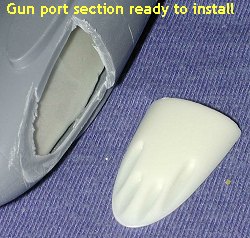 Back at the fuselage, I had to remove a section from the
lower forward part of the nose in order to install the resin bit that held
the cannon. Why this wasn't originally molded into the fuselage halves I
don't know, but the procedure is pretty simple. I first started scribing
the old section with the sharpest scalpel I had. Thanks to the soft
plastic, it took little time to get the outline properly delineated. Then I
used the same scalpel to start cutting into the plastic. Within a few
minutes, the area was free. It was then sanded smooth and after a few test
fits and sanding, the resin gun section was glued in place. I then used Mr.
Surfacer 500 to show where the gaps were and filled those with putty. When
dry, the area was sanded smooth. Thanks to the combination of Mr. Surfacer
and regular putty, it was a one step operation.
Back at the fuselage, I had to remove a section from the
lower forward part of the nose in order to install the resin bit that held
the cannon. Why this wasn't originally molded into the fuselage halves I
don't know, but the procedure is pretty simple. I first started scribing
the old section with the sharpest scalpel I had. Thanks to the soft
plastic, it took little time to get the outline properly delineated. Then I
used the same scalpel to start cutting into the plastic. Within a few
minutes, the area was free. It was then sanded smooth and after a few test
fits and sanding, the resin gun section was glued in place. I then used Mr.
Surfacer 500 to show where the gaps were and filled those with putty. When
dry, the area was sanded smooth. Thanks to the combination of Mr. Surfacer
and regular putty, it was a one step operation.
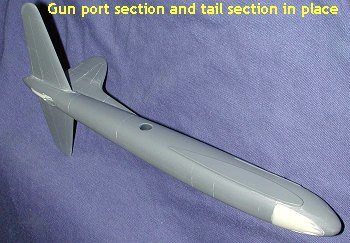 Then the tail sections were glued in place. These are all
butt joins so one has to be rather careful when gluing these down. This is
especially true of the vertical stab. You have a flat bottom that has to
mate with a rounded upper fuselage so it won't be a seamless fit. Filler
took care of that. There is a smaller piece that helps blend it in with the
fuselage. The horizontal stabs are also butt fits so I flooded the join
area with cement to get the best join I could. Much to my disgust, I noted
(after all the parts had been glued and the seams filled) that the fin
wasn't on perfectly straight to the fuselage center line, being off by
about a degree. I'll have to live with it. It wasn't uncommon for vertical
stabs to be offset, but I don't think the Sea Hornet was one of them!
Then the tail sections were glued in place. These are all
butt joins so one has to be rather careful when gluing these down. This is
especially true of the vertical stab. You have a flat bottom that has to
mate with a rounded upper fuselage so it won't be a seamless fit. Filler
took care of that. There is a smaller piece that helps blend it in with the
fuselage. The horizontal stabs are also butt fits so I flooded the join
area with cement to get the best join I could. Much to my disgust, I noted
(after all the parts had been glued and the seams filled) that the fin
wasn't on perfectly straight to the fuselage center line, being off by
about a degree. I'll have to live with it. It wasn't uncommon for vertical
stabs to be offset, but I don't think the Sea Hornet was one of them!
Back at the cockpit, I painted the area just forward and just aft with black. Then I scribed around one of the two canopies and after several passes, just snapped the canopy out of its backing. It works well with regular vac bits and thanks to the semi-thick clear plastic used for the canopy, works well with it as well. I did discover that the canopy is a tad too short to completely cover the cockpit opening, which is probably why a lot of folks build this kit with the canopy open! Installing the canopy wasn't a piece of cake for me, either. I had all sorts of trouble filling the gaps and eventually got to something that looked fairly nice, but not something I really liked in the end. It is the usual story of vac canopies and me!
 The next step was to glue on the wings. One has to be
careful and be sure that the resin radiators don't interfere with the
process so trimming them a touch isn't a bad idea. Attaching the wings is a
bit tricky so I went slowly and made sure each one was on and set up
properly before going on to the next step.
The next step was to glue on the wings. One has to be
careful and be sure that the resin radiators don't interfere with the
process so trimming them a touch isn't a bad idea. Attaching the wings is a
bit tricky so I went slowly and made sure each one was on and set up
properly before going on to the next step.
And that was the landing gear. The main gear is a mixture
of resin and plastic. Actually, the resin is a small part of things and is
only for a strut hinge and a gear bumper. These are easy to remove from the
pouring stub with a hobby knife and are shaped to fit the strut. The upper
arms have small pegs to fit into non-existent holes in the main gear.
You'll have to trim those off or drill the holes. I trimmed them off. The
arms also are a bit short in the distance between the two legs, but this
turns out to be a good thing. I attached the lower portions (nearer the
wheel) on the joins and the upper ones ended up a bit below where you'd
think they'd normally go. I also shortened the connecting arm of the
retraction strut so that the assembly would fit into the wheel well. Even
then it is a bit difficult to fit the main gear into the well.
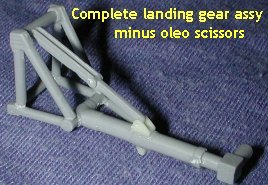
At this time, I should point out that the main gear of the Hornet have a pronounced forward lean. They are not vertical in the gear well. This means that the aft portion of the landing gear (which is what we just glued on) will not mate with the floor of the wheel well. The choices here are to put some sort of extension under these parts or just to glue the gear in place and leave it at that. Those of you really into contests will have to do some major revamping to get it all to be prototypical. I then installed the oleo scissors after cutting them off the sprue. Fit of the lower one is fine. The upper one needs some sort of flat support as it looks a bit odd just sitting attached to one small area.
Next I sanded the areas on the wing where I applied filler.
Then the small trim tab actuators on the
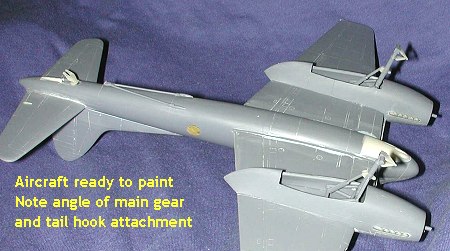 horizontal and vertical
stabilizers were glued in place. There is a spare of these tiny parts in
case you mess one up or lose one. I then sprayed the cockpit area with a
dark grey to highlight all the mess I made with the super glue so I could
clean it up as best as possible. Then considerable time was spent trying to
make things a bit neater than they were. Some success was obtained. When
all that fussing was done, I glued on the main landing gear and resin tail
gear. I made sure there was sufficient forward rake to the main gear to
match the images in the reference. The last bit added was the tail hook and
mounting brackets. Once that was done and dry, it was time to head for the
paint shop. As a side note, I decided to forego attaching the wing racks
for the bombs and rockets. Two reasons, one is that of the photos I have,
it is just as often seen with them as not. Secondly, it just makes for a
much cleaner looking airplane!
horizontal and vertical
stabilizers were glued in place. There is a spare of these tiny parts in
case you mess one up or lose one. I then sprayed the cockpit area with a
dark grey to highlight all the mess I made with the super glue so I could
clean it up as best as possible. Then considerable time was spent trying to
make things a bit neater than they were. Some success was obtained. When
all that fussing was done, I glued on the main landing gear and resin tail
gear. I made sure there was sufficient forward rake to the main gear to
match the images in the reference. The last bit added was the tail hook and
mounting brackets. Once that was done and dry, it was time to head for the
paint shop. As a side note, I decided to forego attaching the wing racks
for the bombs and rockets. Two reasons, one is that of the photos I have,
it is just as often seen with them as not. Secondly, it just makes for a
much cleaner looking airplane!
|
CAMOUFLAGE & MARKINGS |
There are several options available to the modeler for silver finishes. One is to use a dedicated silver color. The other is to use a metallic finish such as Alclad II, SnJ, or Metallizer and apply a clear coat to it in order to cut down on its sheen. I chose the silver paint route on this one. I had a tinlet of Extracolor French silver that I used for the majority of the airframe. I painted the landing gear and wheel wells with Alclad II Dark Aluminum and the wheels themselves with regular Aluminum.
 The Xtracolor paint is really
superb and after a few light coats, I got a great painted aluminum
finish. Non only that, but it is gloss so applying decals is very easy.
Downside is that any application of glue (and that includes superglue)
requires that the glued area be stripped of paint or it will be
permanently wrinkled. I'm not really sure why it is that Xtracolor
behaves in such a fashion, but it does and one just has to learn to live
with it. Fortunately, the Sea Hornet has little in the way of external
add-on bits.
The Xtracolor paint is really
superb and after a few light coats, I got a great painted aluminum
finish. Non only that, but it is gloss so applying decals is very easy.
Downside is that any application of glue (and that includes superglue)
requires that the glued area be stripped of paint or it will be
permanently wrinkled. I'm not really sure why it is that Xtracolor
behaves in such a fashion, but it does and one just has to learn to live
with it. Fortunately, the Sea Hornet has little in the way of external
add-on bits.
The kit decals are superbly printed by Microscale. They are also nicely thin, but not too much so and go one very nicely. I used the Microscale system and the decals held on beautifully. One small problem I noted is that when I went to wipe off an area under the fuselage where excess solution had dried, it also removed the paint. First time I've had that happen so it must be the Xtracolor. Not a problem as I simply reapplied it.
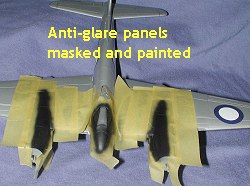 While adding the
markings, I happened to notice that I had forgotten to put on the black
anti-glare panels! Thankfully, the model is not covered with a plethora
of small detail decals so I was able to mask off the nose and nacelles.
Some additional tape was applied to prevent overspray and I carefully
applied the matte black. Thankfully, no problem. I should also mention at
this time that the two lightning bolt decals are mis-placed on the
instruction sheet and should go on the opposite sides that are shown.
While adding the
markings, I happened to notice that I had forgotten to put on the black
anti-glare panels! Thankfully, the model is not covered with a plethora
of small detail decals so I was able to mask off the nose and nacelles.
Some additional tape was applied to prevent overspray and I carefully
applied the matte black. Thankfully, no problem. I should also mention at
this time that the two lightning bolt decals are mis-placed on the
instruction sheet and should go on the opposite sides that are shown.
The masking was removed and the kit then had a thin coat of clear gloss applied to seal in the decals. Once dried, I very lightly misted matte clear just to cut back on some of the gloss.
|
FINAL CONSTRUCTION |
 Not much to the final bits on this one. The axles are a bit long so
before gluing on the wheels, I trimmed them back a touch. The tail wheel
was also glued in place. Fit on this is quite good. I then added the main
gear doors. These are a bit on the difficult side to fit as they only
have a very small contact area that can be used. One really needs to make
hinges for them, but for this review, I glued them in place. I also had
to do quite a bit of cleanup on them so they weren't exactly pristine
when attached. Even though they were pre-painted, I needed to paint them
again, but waited until they were glued in place. I masked off the
landing gear to prevent overspray from messing those up and then. Then
the gear doors and a few other places I wasn't happy with were touched
up.
Not much to the final bits on this one. The axles are a bit long so
before gluing on the wheels, I trimmed them back a touch. The tail wheel
was also glued in place. Fit on this is quite good. I then added the main
gear doors. These are a bit on the difficult side to fit as they only
have a very small contact area that can be used. One really needs to make
hinges for them, but for this review, I glued them in place. I also had
to do quite a bit of cleanup on them so they weren't exactly pristine
when attached. Even though they were pre-painted, I needed to paint them
again, but waited until they were glued in place. I masked off the
landing gear to prevent overspray from messing those up and then. Then
the gear doors and a few other places I wasn't happy with were touched
up.
The exhaust were brush painted with Burnt Iron metallizer. I drilled a small hole in the left wing near the tip for the pitot tube (which somehow wasn't mentioned in the instructions) and inserted a small piece of tubing. I then painted the wing tip lights and removed the masking from the clear bits. I painted on some Vallejo clear gloss acrylic on the windscreen to clear it up a bit. The props were then attached, a bit of pastel used for exhaust stains and that was it. As a bit of a hint, I found the props to be a touch loose on the shaft. What I did was to gently deform the prop shaft with a pair of pliers. It then made the props fit much tighter and I didn't have to glue them on.
|
CONCLUSIONS |
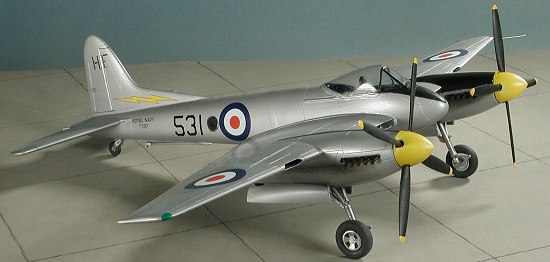 This is by far the nicest Classic Airframes kit I've
built. It's clean lines make it really look great in the overall silver
finish and I know it will be a favorite for a long time. I had no real problems that were not self-induced. The kit goes
together well and really looks great when done. I highly recommend some
sort of material under the rear braces of the landing gear as the single
attachment point that one has to use to give the plane the proper stance
makes it a bit wobbly. I'm sure that some will
be taking me to task for not putting on the wing racks and scrounging
some weapons for them, but I really hated to 'dirty up' the super clean
lines of the Sea Hornet. Maybe the next one. It is a great kit, still easy to find, and you'll
be most pleased with the finished result.
This is by far the nicest Classic Airframes kit I've
built. It's clean lines make it really look great in the overall silver
finish and I know it will be a favorite for a long time. I had no real problems that were not self-induced. The kit goes
together well and really looks great when done. I highly recommend some
sort of material under the rear braces of the landing gear as the single
attachment point that one has to use to give the plane the proper stance
makes it a bit wobbly. I'm sure that some will
be taking me to task for not putting on the wing racks and scrounging
some weapons for them, but I really hated to 'dirty up' the super clean
lines of the Sea Hornet. Maybe the next one. It is a great kit, still easy to find, and you'll
be most pleased with the finished result.
December 2003
#1294 in a series
|
REFERENCES |
Warpaint #19: de Havilland Hornet and Sea Hornet by Tony Butler, Hall/Park Books, Ltd
Copyright ModelingMadness.com. All rights reserved. No reproduction in any form without express permission from the editor.
If you would like your product reviewed fairly and fairly quickly, please contact the editor or see other details in the Note to Contributors.
Back to the Reviews Index Page 2017